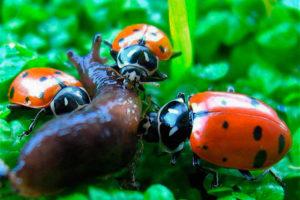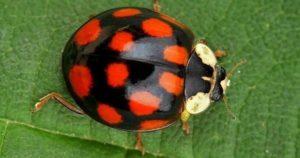Ladybug: the benefits and harms of a bright beetle
Ladybugs are one of the few insects that people like. They were often picked up in childhood, made a wish and released into the sky, singing a children's song. And these bugs also have a lot of benefits.
Content
What are ladybugs
In central Russia, the most common are the usual red beetles with black spots. But there are more than 4000 species, they can be of different shades. There are individuals:
- yellow;
- brown;
- orange;
- blue;
- green-blue;
- with white dots.
Animals are ubiquitous and can live in different cultures and areas. Their bright color is a kind of protective mechanism - it warns animals that the beetle is poisonous.
The benefits and harms of ladybugs
These animals have a big and important mission. They help people fight harmful insects. But there is also a bit of harm from cute creatures.
The benefits of ladybugs
These small cute animals are real predators. They eat a lot, both adults and maturing larvae. They eat a lot of aphids.
But in addition to these parts of the diet, they do not mind feasting on:
- shields;
- sawflies;
- psyllids;
- ticks.
One adult ladybug can eat up to 50 aphids per day. And the larva is much more voracious. If there is an outbreak of these bugs, and this happens, then the gardens are in danger.
Harm of ladybugs
It happens that there are a lot of beetles. They wander into dwellings and fill all the cracks with themselves. Such a neighborhood is not pleasant, and sometimes dangerous.
Vegetarian ladybugs
Among the 4000 species of ladybugs, there are several that prefer to eat plants. They are recognized as agricultural pests and are being fought against. On the territory of Russia there are only three types:
- 28-point;
- melon;
- alfalfa.
The first is one of the most voracious potato pests.
Moreover, a small ladybug does no less harm than the Colorado potato beetle.
The rest of the vegetarians eat a huge amount of crops. Small larvae are located on the back of the leaf, feed on young and juicy pulp. At risk:
- melon;
- watermelon;
- zucchini;
- pumpkin;
- cucumbers;
- tomatoes;
- eggplants;
- spinach;
- salad.
Biting ladybugs
Among the cute little beetles, there are aggressive species. These are Asian ladybugs. They multiply rapidly and adapt well to different living conditions.
They call her harlequin or 19-point ladybug.
It is not easy to distinguish them, because outwardly they are similar to other species. Colors can be different, from yellowish to almost black. But after the head there is a white stripe, which is quite difficult to notice.
The Asian ladybug, in addition to aphids and small insects, with a lack of nutrition, passes to grapes and berries or fruits. Gnawing jaws can harm people - they bite painfully.
Ladybug lifestyle
Ladybugs themselves are not harmful. But there is something to be afraid of.
In self-defense, the beetles secrete a yellow liquid, geolymph, which is poisonous and has an unpleasant odor. If it comes into contact with the skin, an allergic reaction may occur. And these stains on furniture or walls do not decorate at all.
Scientists sometimes amaze with their discoveries. One concerns ladybugs - they lead a hectic lifestyle. For them, a frequent occurrence of a disease that is sexually transmitted and a large number of ticks that live under the elytra.
Conclusion
Ladybugs are cute little bugs that look harmless. They are of great benefit to agriculture, helping to fight pests. But you need to be careful with them, because they can carry parasites and show aggression towards people.
Previous

